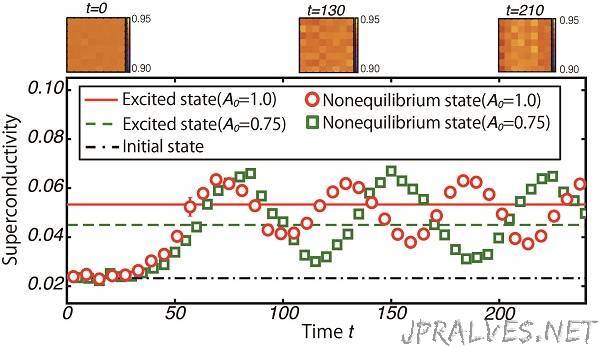
“A University of Tokyo research group has found that the superconductivity of materials in strongly correlated electron systems—that is, materials characterized by strong interactions between the electrons—can be enhanced beyond that achieved in thermal equilibrium by irradiation with a strong laser. The current findings hold promise of paving the way for research on regulating the superconductivity transition temperature with light, and applying the research toward developing new devices.
Realizing superconductivity at room temperature is one of the Holy Grails of condensed matter physics. Although the highest critical temperature for superconductivity at ambient pressure was recorded in copper oxide superconductors (cuprates) at around minus 140 degrees Celsius decades ago, the situation has essentially remained the same despite multiple efforts to raise the temperature to within room-temperature range. One reason for this is that the strong attraction between electrons required for realizing a higher transition temperature drives the tendency to pull and clump electrons together into a nearby location, thereby forming an uneven spatial distribution of electrons, which suppresses superconductivity. In order to break through this stalemate in equilibrium, researchers have increasingly been utilizing nonequilibrium processes, such as laser irradiation, in recent years as a new way for regulating the transition temperature, and controlling and enhancing superconductivity in materials.
The research group led by graduate student Kota Ido, Project Assistant Professor Takahiro Ohgoe, and Professor Masatoshi Imada at the Department of Applied Physics, Graduate School of Engineering, the University of Tokyo, performed computer simulations of electron dynamics in a standard model for strongly correlated electron systems (cuprates) by using a state-of-the-art numerical method, capable of dealing with electronic interaction effects accurately. As a result, the group found a way to realize a dynamic stable state with outstanding superconductivity not only by strong laser irradiation, which strengthens the effective repulsive interaction between electrons and thereby paradoxically enhances the emergent attraction, but also by circumventing the inhomogeneities in electron distribution, found in the equilibrium case, which strongly suppress superconductivity.
The current research outcome promises to pave the way for realizing superconductivity at room temperature for correlated electron materials. The research group plans to conduct further experiments to test its theory, obtained through these findings, that strong laser irradiation indeed enhances superconductivity. This study opens up further research for not only determining the suitability of different types of light for irradiation to control physical properties in materials based on theoretical guidelines obtained through computer simulations, but also its application to the development of new devices based on the research utilizing light.
“Most studies until now for high-temperature superconductivity were conducted primarily under equilibrium conditions,” says Ido. He continues, “It was very hard to simulate the dynamics of superconductivity in strongly correlated electron systems like those in our present study, but we succeeded by developing a state-of–the-art method, which we used. We expect that our findings will stimulate further studies on nonequilibrium superconductivity in strongly correlated electron systems.”“
